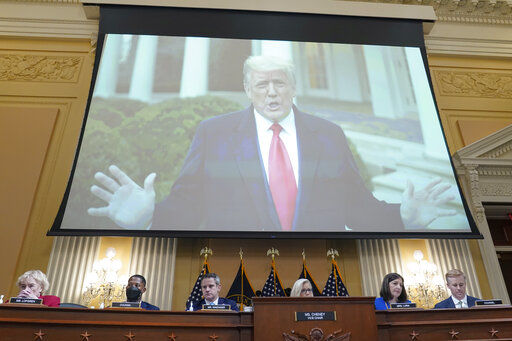
9 A.M. UPDATE
WASHINGTON — The House Jan. 6 committee offered new details Thursday about the 187 minutes — from 1:10 pm to 4:17 pm — that elapsed between the end of President Trump’s speech to supporters near the White House and the video he put out urging the mob storming the Capitol to go home.
The committee showed that Trump spent most of those three hours in the White House dining room. As Fox News played in the background, the former president called senators to urge them to help delay the electoral count and ignored pleas from his advisors to help end the insurrection.
“For 187 minutes on January 6, [2021], this man of unbridled destructive energy could not be moved,” Chairman Bennie Thompson, D-Miss., said at the start of the hearing.
Here are four key takeaways from the hearing:
Trump’s hours in the White House dining room
The White House records of what happened during the insurrection are limited. There were no details in the official call log, nothing recorded in the White House Daily Diary and no photos taken.
Several witnesses who testified in depositions before the committee said they weren’t aware of the president reaching out to law enforcement agencies for help. Instead, he was making calls in an attempt to secure another term. Former White House press secretary Kayleigh McEnany testified that Trump asked her for a list of senators to contact, which she left with him.
Trump also spoke with his lawyer, Rudolph W. Giuliani, according to Giuliani’s phone records.
Later in the afternoon, as Vice President Mike Pence was evacuated from the Capitol, the president called Sen. Tommy Tuberville, R-Ala. The senator later told a local news outlet that he had to end the call with the president because he was also being evacuated.
Trump, Meadows were bombarded with requests to send mob home
Several Trump staffers, members of Congress, conservative media personalities and members of the president’s own family either urged Trump directly to call off the rioters or contacted his chief of staff Mark Meadows to make their pleas.
According to witnesses and text message records, that list included former White House Counsel Pat Cipollone; Trump’s children, Ivanka Trump and Donald Trump Jr.; Fox News’ Sean Hannity, Laura Ingraham and Brian Kilmeade; Republican Reps. Chip Roy of Texas, Jeff Duncan of South Carolina, Barry Loudermilk of Georgia; and House Minority Leader Kevin McCarthy.
Jared Kushner, Trump’s son-in-law, testified that McCarthy also called him, asking for any help possible.
“I got the sense that they were scared,” Kushner said.
Sarah Matthews, a former deputy press secretary and special assistant to the president, said it would have taken Trump less than 60 seconds to walk from the dining room to the press briefing room to address the public. It would have taken a few minutes to assemble the White House press corps to cover remarks from the Oval Office, she said.
“If the president had wanted to make a statement and address the American people, he could have been on camera almost instantly,” she said.
Rep. Adam Kinzinger, R-Ill., who helped lead Thursday’s hearing with Rep. Elaine Luria, D-Va., and committee Vice Chair Liz Cheney, R-Wyo., said there were concerns among the president’s team that his unscripted comments could cause further damage.
“For example, Gen. Keith Kellogg told us that some staff were concerned that a live appearance by the president at the microphones at that moment could actually make matters worse,” Kinzinger said, referring to Pence’s former national security adviser. “He told us he recommended against doing a press conference because during his four years in the Trump administration, ‘There wasn’t a single clean press conference.'”
Trump’s Jan. 6 tweet on Pence came as he was being evacuated
At 2:24 p.m. that day, Trump tweeted that Pence “didn’t have the courage to do what should have been done.”
As the insurrection unfolded, the president’s national security council staff was listening to radio traffic of the Secret Service agents protecting Pence.
At 2:13 p.m., a national security council staffer noted that the windows of the Capitol were being kicked in, according to excerpts from the staffer’s chat box. Three minutes later a staffer wrote Pence was being pulled out. As the Trump tweet went out, a staffer wrote that the agents protecting Pence didn’t “sound good.”
A White House security official the committee allowed to testify anonymously said the vice president’s security detail feared for their lives and were calling to say goodbye to family members.
Matthews and Matthew Pottinger, a former deputy national security adviser to Trump, testified before the panel Thursday and said the tweet inflamed the situation.
“It was essentially him giving the green light to these people,” Matthews said. “He shouldn’t have been doing that. He should have been telling these people to go home and to leave, and to condemn the violence that we were seeing.”
She said the tweet was Trump “pouring gasoline on the fire and making things much worse.”
What happened after Trump finally told the rioters to leave
Witnesses also described the efforts in the White House and the Capitol to resume the electoral count and reassure the public — and those watching around the world — that there would be a peaceful transition of power in the hours and days following the attack.
Then-Senate Majority Leader Mitch McConnell, R-Ky., and Minority Leader Chuck Schumer, D-N.Y., asked officials when it would be safe to return to the Capitol. After the president’s Twitter account was suspended on Jan. 6, Trump adviser Jason Miller urged the president to say in a tweet from deputy chief of staff Dan Scavino’s account that there would still be an “orderly transition” of power.
Former Secretary of Labor Eugene Scalia sent a memo to the president requesting a Cabinet meeting to show that the president was listening to them and not “certain private individuals” who had served him “poorly” with their advice.
“Though Secretary Scalia did not say it, he was referring to Rudy Giuliani and the rest of the so-called ‘clown car’ working with President Trump to try to overturn the election,” Kinzinger said. Scalia also asked the president to stop publicly challenging the results of the election.
Inside the White House, staffers sought to control the fallout from Jan. 6. Amid fears that the Cabinet would invoke the 25th Amendment to remove him from power, the president recorded another video message on Jan. 7 to condemn the attack. But, as raw footage from that video shows, he was still unwilling to say he lost the election.
“I don’t want to say the election is over,” Trump said in a clip. “I just want to say Congress has certified the results.”
ORIGINAL STORY
WASHINGTON — Then-President Donald Trump’s refusal for more than three hours to call off the mob attacking the Capitol on Jan. 6 constituted a dereliction of duty, the House committee investigating the insurrection said in its prime-time hearing Thursday.
“The mob was accomplishing President Trump’s purpose, so of course he didn’t intervene,” Rep. Adam Kinzinger, R-Ill., said. “President Trump did not fail to act during the 187 minutes between leaving the Ellipse and telling the mob to go home. He chose not to act.”
For nearly three hours, as a violent mob raged at the U.S. Capitol, Trump did not leave his private dining room at the White House, where he watched the events of the day play out on television and chose not to intervene.
He did not speak to National Security leaders, law enforcement, congressional leaders or Vice President Mike Pence. He had to be pressured by family and staff into sending tweets urging rioters not to harm police and to be peaceful, committee members said.
And it was only once lawmakers were in safe rooms and law enforcement had begun regaining control of the Capitol that Trump agreed to shoot a video urging his supporters to withdraw and go home.
“Whatever your politics, whatever you think about the outcome of the election, we as Americans must all agree on this: Donald Trump’s conduct on Jan. 6 was a supreme violation of his oath of office and a complete dereliction of his duty to our nation,” Kinzinger said. “It is a stain on our history. It is a dishonor to all those who have sacrificed and died in service of our democracy.”
Focusing on Trump’s inaction, the panel provided a moment-by-moment accounting of the 187 minutes between the beginning of the attack on the Capitol and his release of a video on Twitter urging his supporters to withdraw.
Trump became aware of the mob’s violence immediately after his speech at the Ellipse near the White House, said Rep. Elaine Luria, D-Va., who led the hearing with Kinzinger.
“Within 15 minutes of leaving the stage, President Trump knew that the Capitol was besieged and under attack,” Luria said.
Instead of taking action, Trump spent hours in the White House making calls to senators, asking them to block then-President-elect Joe Biden from taking office, and spoke with his attorney Rudolph W. Giuliani. Records of the president’s daily movements and phone logs from that day show no entries between the time Trump returned to the White House and his release at 4:17 p.m. of the video telling supporters to go home.
“There is no official record of what President Trump did while in the dining room.… The chief White House photographer wanted to take pictures because it was, in her words, ‘Very important for his archives and for history.’ But she was told, quote, ‘No photographs,’” Luria said.
White House Counsel Pat Cipollone said in a clip from his deposition with the committee that soon after the violence began, he, Chief of Staff Mark Meadows, Trump’s daughter Ivanka Trump and White House lawyer Eric Herschmann all pleaded with Trump to issue a statement telling the mob to leave. Other staff from the West Wing came into the dining room to plead with Trump, and members of Congress called his family and staff when they couldn’t get through to him.
“The president didn’t want anything done,” said a former White House employee granted anonymity by the committee.
The panel showed other video of top-ranking national security and White House officials saying one by one that Trump did not speak to leaders of the Defense Department, National Guard, FBI, Homeland Security or the Secret Service. Nor did Trump communicate with Washington, D.C., Mayor Muriel Bowser or U.S. Capitol Police officials.
In a clip from his deposition, Chairman of the Joint Chiefs of Staff Mark A. Milley questioned why Trump didn’t act.
“You’re the commander in chief,” Milley said. “You’ve got an assault going on on the Capitol of the United States of America, and there’s nothing? No call? Nothing? Zero?”
Former White House press aide Sarah Matthews and former deputy national security adviser Matthew Pottinger, who were at the White House on Jan. 6 and resigned over Trump’s actions that day, were witnesses at Thursday’s hearing.
Pottinger had served on the National Security Council throughout Trump’s presidency and was one of the highest-ranking officials to resign that day. The former Marine intelligence officer and was in the vicinity of the Oval Office at various points throughout the day.
Matthews had worked in Congress and for the Trump campaign before serving as his deputy press secretary. She stressed that Trump could have walked from the dining room, where he stayed for most of the attack, to the White House press room in just 60 seconds, and noted that staff could have quickly assembled the White House press corps in the Oval Office so he could make a public statement.
She said a 2:24 p.m. tweet, in which Trump attacked Vice President Mike Pence for not agreeing to reject the electors of certain states that voted for Biden, was pouring gasoline on a fire.
“It was essentially him giving the green light to these people, telling them that what they were doing at the steps of the Capitol, and entering the Capitol, was OK, that they were justified in their anger,” she said.
The tweet was sent while the Secret Service was trying to move the vice president out of his ceremonial office outside the Senate chamber to an underground garage, where Pence’s motorcade was waiting.
A former White House official with national security responsibility, who was granted anonymity by the committee, gave chilling details of what was coming over the Secret Service radio as Pence and his family were evacuated, passing within 40 feet of the mob at one point.
“Members of the VP detail at this time were starting to fear for their own lives” and there were calls to “say goodbye to loved ones” because the security team thought things were “about to get very ugly,” the person said.
Matthews said she found the video Trump released at 4:17 p.m. “indefensible.” In the video, he told supporters, “We love you. You’re very special. You’ve seen what happens; you see the way others are treated that are so bad and so evil. I know how you feel, but go home and go home in peace.”
The committee said Trump refused to read from the script he was given by his staff, and instead ad-libbed his remarks.
“As a spokesperson for him, I knew that I would be asked to defend that, and to me, his refusal to act and call off the mob that day, and his refusal to condemn the violence, was indefensible,” Matthews said. “And so I knew that I would be resigning that evening.”
The committee also showed outtakes from a speech Trump gave the evening of Jan. 7. His staff had prepared the text for him that morning, but Trump resisted making the speech until threats to remove him from office under the 25th Amendment were raised.
In the video, Ivanka Trump can be heard helping her father work through what he was willing to say. At one point, the president appeared to smack the lectern in anger.
“I don’t want to say, ‘the election is over.’ I just want to say ‘Congress has certified the results’ without saying ‘the election is over.’ OK?” Trump said in one of the outtakes.
In her opening statement, Vice Chair Liz Cheney, R-Wyo., said that the hearings had brought forward new tips, witnesses and evidence, and that the investigation would continue.
“Doors have opened, new subpoenas have been issued and the dam has begun to break,” she said.
Cheney praised the young former White House staffers, including Cassidy Hutchinson, who have given damning testimony and have been attacked for it by Trump supporters. Cheney reminded those criticizing the committee that nearly all of the testimony had come from Republicans.
“The case against Donald Trump in these hearings is not made by witnesses who were his political enemies. It is instead a series of confessions by Donald Trump’s own appointees, his own friends, his own campaign officials, people who worked for him for years and his own family. They have come forward and they have told the American people the truth,” Cheney said.
Over the previous seven hearings this summer, the committee made the case that Trump knew he had fairly lost his bid for a second term but chose to churn up accusations of a stolen election anyway, and that he pressured state legislatures and Pence to break the law to keep him in power.
The panel has also focused on how Trump nearly replaced the acting attorney general with a supporter when the Justice Department wouldn’t back up his false claims of election fraud.
Chairman Bennie Thompson, D-Miss., who tested positive for COVID-19 earlier this week, participated remotely via video. He said the committee hearings would resume in September.
Committee members have wrestled with whether their final recommendations should include a criminal referral to the Justice Department, or should instead leave the decision to the department, which is conducting its own investigation.
“I think the president certainly has criminal exposure,” Kinzinger said after the hearing. “I’m not a prosecutor, not (Department of Justice). But I certainly think if you look at what we presented tonight and all these hearings, that cannot be acceptable from the president of the United States.”
“The worst thing we can do is put out something that says, ‘The president is above the law and can do this again,’” he added. “Because I guarantee you, it will happen again.”
(Staff writer Anumita Kaur contributed to this report.)




